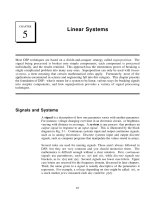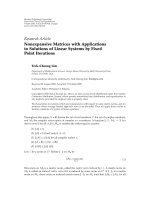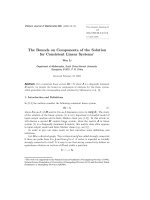LA_1. Linear systems
Bạn đang xem bản rút gọn của tài liệu. Xem và tải ngay bản đầy đủ của tài liệu tại đây (511.11 KB, 37 trang )
<span class='text_page_counter'>(1)</span><div class='page_container' data-page=1></div>
<span class='text_page_counter'>(2)</span><div class='page_container' data-page=2>
<b>OUR GOAL</b>
• <b><sub>Elementary Operations</sub></b>
• <b><sub>Gaussian Elimination </sub></b>
</div>
<span class='text_page_counter'>(3)</span><div class='page_container' data-page=3></div>
<span class='text_page_counter'>(4)</span><div class='page_container' data-page=4></div>
<span class='text_page_counter'>(5)</span><div class='page_container' data-page=5>
• a<sub>1</sub>x<sub>1</sub>+ a<sub>2</sub>x<sub>2</sub>+…+a<sub>n</sub>x<sub>n</sub>=b
is called a <b>linear equation (phương trình tuyến </b>
<b>tính)</b>
• If a<sub>1</sub>s<sub>1</sub>+a<sub>2</sub>s<sub>2</sub>+…+a<sub>n</sub>s<sub>n</sub>= b
(s<sub>1</sub>,s<sub>2</sub>,…,s<sub>n</sub>) is called solution of the equation
• <sub>A system may have: </sub>
<b>no solution</b>
<b>unique solution </b>
an <b>infinite family of solutions </b>
<b>coefficients</b> <b>variables = unknowns</b>
<b>1.1. Solutions and Elementary Operations</b>
<b>0</b>
<b>1</b>
</div>
<span class='text_page_counter'>(6)</span><div class='page_container' data-page=6>
<b>Inconsistent </b>
<b>(không </b>
<b>tương thích)</b>
<b>Consistent </b>
<b>(tương thích)</b>
<b>No solutions </b>
</div>
<span class='text_page_counter'>(7)</span><div class='page_container' data-page=7>
<b>Example 1</b>
•
<b>Inconsistent</b>
<b> Consistent </b>
(infinitely many
solutions)
(0,2,1), (2,0,1) (t,2-t,1)
no solution
(t,2-t,1)
is called a
<b>general solution</b>
and
given in
<b>parametric form</b>
,
t
is
<b>parameter</b>
<b>( t is arbitrary)</b>
2
1
2
3
<i>x</i>
<i>y</i>
<i>x</i>
<i>y</i>
1
3
<i>x y z</i>
<i>x y z</i>
</div>
<span class='text_page_counter'>(8)</span><div class='page_container' data-page=8>
<b>Algebraic Method</b>
<b> constant matrix</b>
<b> augmented matrix</b>
<b> coefficient matrix</b>
1 2 3 4
1 3 4
1 2 3 4
3 2 1
2 2 0
3 2 5 2
<i>x</i> <i>x</i> <i>x</i> <i>x</i>
<i>x</i> <i>x</i> <i>x</i>
<i>x</i> <i>x</i> <i>x</i> <i>x</i>
3 2 1 1 1
2 0 1 2 0
3 1 2 5 2
1
0
2
3 2
1 1
2 0
1 2
3 1
2
5
</div>
<span class='text_page_counter'>(9)</span><div class='page_container' data-page=9>
<b>Example 2 </b>
• Consider the system
<b>augmented matrix </b>
1
2
2
<i>x y</i>
<i>x</i>
<i>y</i>
1 1 1
1 2
2
</div>
<span class='text_page_counter'>(10)</span><div class='page_container' data-page=10>
Solution (0,-1)
<b>Example 2 </b>
1 1
2 2 0 3 3
<i>x y</i> <i>x y</i>
<i>x</i> <i>y</i> <i>x</i> <i>y</i>
1 1 1 1 1 1
1 2 2 0 3 3
1
0 1
<i>x y</i>
<i>x y</i>
1 0
0
1
1
0
0 0
0 1
<i>x</i> <i>y</i>
<i>x y</i>
1 1 1
0 1 1
</div>
<span class='text_page_counter'>(11)</span><div class='page_container' data-page=11>
<b>A </b>
<b>row-echelon matrix</b>
<b> has 3 properties</b>
• <sub>All the zero rows are at the </sub>
bottom
• <sub>The first nonzero entry </sub>
from the left in each
nonzero row is a 1, called
the <b>leading 1</b> for that row
• <sub>Each leading 1 is </sub><b><sub>to the </sub></b>
<b>right</b> of all leading 1’s in
the rows above it
0
* * * * *
0 0 0
* * *
0 0 0 0
* *
0 0 0 0 0
0 0 0 0 0
1
1
1
1
0
0 0
</div>
<span class='text_page_counter'>(12)</span><div class='page_container' data-page=12>
<b>Row-echelon matrix</b>
( for any choice in *-position )
The row-echelon matrix has the “staircase” form
</div>
<span class='text_page_counter'>(13)</span><div class='page_container' data-page=13>
<b>Which is a row-echelon matrix?</b>
1 * *
0 2 *
0 0 1
1 * *
0 0 1
1 * * *
0 1 * *
0 1 * *
0 1 * *
0 0 0 1
0 0 0 0
1 * *
0 0 0
0 0 1
</div>
<span class='text_page_counter'>(14)</span><div class='page_container' data-page=14>
<b>A reduced row-echelon matrix</b>
<b>(ma trận bậc thang theo dòng thu gọn) has the properties</b>
• It is a row-echelon matrix
• Each leading 1 is the <b>only </b>
<b>nonzero</b> entry in its column
1
0 1
0 0 0 1
0
*
0
*
0
</div>
<span class='text_page_counter'>(15)</span><div class='page_container' data-page=15>
<b>Which is a reduced row- echelon </b>
<b>matrix?</b>
1 * 0
0 1 0
0 0 1
1 * 0
0 0 1
1 0 * 0
0 1 * 0
0 0 0 1
0 1 * 0
0 0 0 1
0 0 0 0
1 * 0
0 0 0
0 0 1
</div>
<span class='text_page_counter'>(16)</span><div class='page_container' data-page=16>
<b>How to carry a matrix to </b>
</div>
<span class='text_page_counter'>(17)</span><div class='page_container' data-page=17>
<b>Elementary Operations </b>
<b>(phép biến đổi sơ cấp)</b>
• <b>Interchange</b> two equations (type I)
• <b>Multiply one equation by a nonzero number </b>(type II)
</div>
<span class='text_page_counter'>(18)</span><div class='page_container' data-page=18></div>
<span class='text_page_counter'>(19)</span><div class='page_container' data-page=19>
<b>Gaussian Algorithm</b>
• Step 1. If all row are <b>zeros</b>, stop
• Step 2. Otherwise, find the first column from the left
containing a nonzero entry (call it <i>a</i>) and move the row
containing <i>a</i> to the top position
• Step 3. Multiply that row by 1/a to creat the <b>leading 1</b>
• Step 4. By subtracting multiples of that row from the
rows below it, make each entry below the leading 1
<b>zero</b>
• Step 5. Repeat step 1-4 on the matrix consisting of the
remaining rows
</div>
<span class='text_page_counter'>(20)</span><div class='page_container' data-page=20>
<b>Gaussian Algorithm</b>
<b>step 2</b> <b>step 3</b> <b>step 4</b> <b>step 5</b>
<b>leading one</b>
1 4
4
1
1 0
2
0 0 1 3
0 3 0 6
0
1
3 7 1
<i>r r</i>
<sub></sub> <sub></sub>
0 0 0 0
0 0 0 0
1:
0 0 0 0
0 0 0 0
<i>step</i> <i>stop</i>
<sub> </sub>
1
1
2
4
1
1 0
2
0 0 1 3
0 3 0 6
7 5
1
1
<i>r</i>
0 0 1 3
2 1 0
0 3 0 6
4 7
2
5 1
<sub></sub>
1 2
2 1 0
0 0 1 3
0 3 0 6
2
4 7 5 1
<i>r</i><i>r</i>
</div>
<span class='text_page_counter'>(21)</span><div class='page_container' data-page=21>
<b>Example</b>
Carry the matrix
• to row-echelon matrix
• to reduced
row-echelon matrix
2
6
2 2
2
3 11 4
3
11
3
0
<sub></sub>
<sub></sub>
</div>
<span class='text_page_counter'>(22)</span><div class='page_container' data-page=22>
<b>row-echelon matrix</b>
3
1
7 1 3 1 1
0 1 3 2
0 0 0 1
<i>r</i>
1
1
2
2 6 2 2 1 3 1 1
2 3 11 4 2 3 11 4
3 11 3 0 3 11 3 0
<i>r</i>
<sub></sub> <sub></sub> <sub> </sub> <sub></sub>
1 2
1 3
2
3 1 3 1 1
0 3 9 6
0 2 6 3
<i>r r</i>
<i>r r</i>
2
1
3 1 3 1 1
0 1 3 2
0 2 6 3
<i>r</i>
2 3
2 1 3 1 1
0 1 3 2
0 0 0 7
</div>
<span class='text_page_counter'>(23)</span><div class='page_container' data-page=23>
<b>reduced row-echelon matrix</b>
3 2
3 1
2 1
2
3
1 3
1 1
1 3
1 0
0 1
3
2
0 1
3
0
0 0
0
1
0 0
0
1
1 0
10 0
0 1
3
0
0 0
0
1
<i>r r</i>
<i>r r</i>
<i>r r</i>
<sub></sub>
</div>
<span class='text_page_counter'>(24)</span><div class='page_container' data-page=24>
<b>The rank of a matrix</b>
• <b><sub>The rank of the matrix A</sub></b><sub>, rankA = the </sub>
<i>number of leading ones </i>in the reduced
row-echelon form of A.
Rank 2
1 0 * 0
0 1 * 0
0 0 0 1
</div>
<span class='text_page_counter'>(25)</span><div class='page_container' data-page=25>
<b>Gauss-Jordan Elimination</b>
<b>(for solving a system of linear equations)</b>
• <sub>Step 1.Using elementary row </sub>
operations, <b>augmented matrix </b>
<b>reduced row-echelon matrix</b>
• <sub>Step 2. If a row [</sub><sub>0 0 0…0</sub> <sub>1</sub><sub>] occurs, </sub>
the system is <b>inconsistent</b>
• <sub>Step 3. Otherwise, assign the </sub>
<b>nonleading variables</b> as
parameters, solve for the leading
variables in terms of parameters
<b>reduced row echelon matrix</b>
<b>z is nonleading variable</b>
<b>z=t (parameter)</b>
0 10
0 0 0 0 0
0
1 0 10 0
0 1 3 0 0 1 3 0
1
0
1
<i>x</i> <i>y</i> <i>z</i>
<i>x</i> <i>y</i> <i>z</i>
<i>x</i> <i>y</i> <i>z</i>
<sub></sub>
<sub></sub> <sub></sub> <sub></sub> <sub></sub>
0 10 0
0 1
0 0 0 0 0 0
0 0
0 3 0 0 3 0
1
1
1 1
0 0
<i>x</i> <i>y</i> <i>z</i>
<i>x</i> <i>y</i> <i>z</i>
<i>x</i> <i>y</i> <i>z</i>
</div>
<span class='text_page_counter'>(26)</span><div class='page_container' data-page=26>
<b>inconsistent</b>
1 2
1 3
2
3
Solve the following system of equations
2 3
2 3 2 5
3 7 2 10
Solution.
Carry the augmented matrix to reduced row-echelon form
1 2 0 3 1 2 0 3
2 3 2 5 0 1 2 1
3 7 2 10 0 1 2 19
<i>r r</i>
<i>r r</i> <i>r</i>
<i>x</i> <i>y</i>
<i>x</i> <i>y</i> <i>z</i>
<i>x</i> <i>y</i> <i>z</i>
<sub></sub>
2 3
3
1
20
1 2 0 3
0 1 2 1
0 0 0 20
1 2 0 3
0 1 2 1
0 0 0 1
</div>
<span class='text_page_counter'>(27)</span><div class='page_container' data-page=27>
<b> reduced row echelon matrix</b>
<b>leading one</b>
x<sub>2</sub>,x<sub>4</sub> are <b>nonleading </b>
<b>variables</b>, so we set
x<sub>2</sub>=t and x<sub>4</sub>=s
(parameters) and then
compute x<sub>1</sub>, x<sub>3</sub>
x<sub>1</sub> = 2 + 2t - s
x<sub>2</sub> = t
x<sub>3</sub> = 1 + 2s
x<sub>4</sub> = s
1 2 1 3 1 1 2 1 3 1
2 4 1 0 5 0 0 3 6 3
1 2 2 3 4 0 0 3 6 3
1 1
1 1
2 1 3 1 2 0 1 2
0 0 2 1 0 0 2 1
0 0 0 0 0 0 0 0 0 0
<sub></sub> <sub></sub> <sub></sub>
<sub></sub> <sub></sub> <sub></sub> <sub></sub>
</div>
<span class='text_page_counter'>(28)</span><div class='page_container' data-page=28></div>
<span class='text_page_counter'>(29)</span><div class='page_container' data-page=29></div>
<span class='text_page_counter'>(30)</span><div class='page_container' data-page=30>
<b>Theorem 2</b>
Suppose a system of m equations in n variables
has a solution. If the rank of the augment matrix
is r then the set of solutions involves exactly n-r
parameters
<b> rankA=2</b>
<b>leading one</b>
<b>4(number of variables)- 2(rankA) =2 </b>
<b>(two parameters : x<sub>2</sub>=t, x<sub>4</sub>=s)</b>
1 2 1 3 1 1 2 1 3 1 2 1 3 1
2 4 1 0 5 0 0 3 6 3 0 0 2 1
1 2 2 3 4 0 0 3 6 3 0 0 0 0
1
1
0
<sub></sub> <sub></sub> <sub></sub>
</div>
<span class='text_page_counter'>(31)</span><div class='page_container' data-page=31>
<b>1.3.Homogeneous Equations</b>
<b>(phương trình thuần nhất)</b>
• The system is called <b>homogeneous (thuần nhất) if </b>
the constant matrix has all the entry are zeros
• Note that every homogeneous system <b>has at least </b>
<b>one solution (0,0,…,0),</b> called <b>trivial solution</b>
(nghiệm tầm thường)
• If a homogeneous system of linear equations has
</div>
<span class='text_page_counter'>(32)</span><div class='page_container' data-page=32></div>
<span class='text_page_counter'>(33)</span><div class='page_container' data-page=33>
Hệ thuần nhất mà số ẩn
nhiều hơn số pt
</div>
<span class='text_page_counter'>(34)</span><div class='page_container' data-page=34>
<b>Theorem 1</b>
If a homogeneous system of linear equations
has <b>more variables than equations</b>, then it has
nontrivial solution (in fact, infinitely many)
</div>
<span class='text_page_counter'>(35)</span><div class='page_container' data-page=35>
<b>System of equations Summary </b>
<b>System of</b> <b>Inconsistent</b>
<b>( no </b>
<b>solutions)</b>
<b>Cosistent</b>
<b>Unique solution </b>
<b>(exactly one </b>
<b>solution)</b>
<b>Infinitely many </b>
<b>solutions</b>
<b>linear equations</b> <b>yes</b> <b>yes</b> <b>yes</b>
<b>linear equations that </b>
<b>has more </b>
<b>variables than </b>
<b>equations</b>
<b>yes</b> <b>no</b> <b>yes</b>
<b>homogeneous linear </b>
<b>equations</b> <b>no</b> <b>yes</b> <b>yes</b>
<b>homogeneous linear </b>
<b>equations that has </b>
<b>more variables </b>
<b>than equations</b>
</div>
<span class='text_page_counter'>(36)</span><div class='page_container' data-page=36>
<b>Summary </b>
<b>Elementary Operations</b>
<b>Gaussian Elimination </b>
</div>
<span class='text_page_counter'>(37)</span><div class='page_container' data-page=37></div>
<!--links-->









